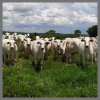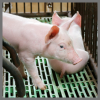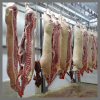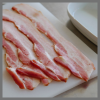-

Jun
15
Interpretive Summary: Genetic parameters for fleece uniformity in alpacas

The quality of alpaca fiber is mainly assessed by a low fiber diameter. However, the fiber diameter can greatly vary along the different body locations of the animal, the industry demands not only the fineness of the fiber but also the fleece uniformity.
Read more
-

Jun
15
Interpretive Summary: Genetic parameters for mouth size and their influence on growth traits in pasture-raised Nelore cattle

Evaluating traits that allow breeders to increase production efficiency in beef production systems is important. The mouth size (MS) score is a trait easily measured and implemented by breeders. Our results showed that MS in Nelore cattle is a heritable trait, and it is favorably associated with growth traits, indicating that animals with larger mouth are heavier at weaning and gain more weight after weaning on pasture.
Read more
-

Jun
15
Interpretive Summary: Reproductive performance and transcriptome analysis of ovaries at different parities in female rabbits

The pregnancy data of 658 female rabbits from the first to sixth parities (P1 to P6) under the same mating pattern were used to assess the rate of conception at different parities. The reproductive performance and follicular development of P1, P2, and P6 female rabbits were analyzed. The results showed that conception rate was dramatically reduced in P6.
Read more
-

Jun
08
Interpretive Summary: Impact of shade in beef feedyards on performance, ear temperature, and heat stress measures

This study was performed over two separate summers to evaluate natural exposure to heat and quantify the impact that providing shade has on stress measures, estimates of body temperature, and feedlot performance.
Read more
-

Jun
08
Interpretive Summary: Inclusion of Berberis vulgaris leaf in the diet of fattening lambs: effects on performance, nutrient intake, rumen fermentation, and carcass traits

Barberry (Berberis vulgaris) leaf (BVL) is an agricultural by-product rich in plant secondary compounds such as alkaloids, flavonoids, anthocyanins, and tannin. The present study was aimed to first, evaluate in vitro nutritional value of BVL and second, explore the effects of BVL inclusion in finishing lambs diet (at levels of 0%, 7.5%, and 15% dry matter [DM] of diet), in partial replacement of alfalfa hay, on performance, carcass characteristics, and ruminal fermentation.
Read more
-

Jun
08
Interpretive Summary: Efficacy of a bacterial 6-phytase supplemented beyond traditional dose levels on jejunal mucosa-associated microbiota, ileal nutrient digestibility, bone parameters, and intestinal health, and growth performance of nursery pigs

After weaning, pigs start to receive solid diets throughout nursery phase with high amounts of plant-based feedstuffs containing various antinutritional and allergenic compounds. Feed enzymes have been used in nursery diets to reduce or remove the negative impacts associated with these compounds.
Read more
-

Jun
08
Interpretive Summary: Metabolizable energy and apparent total tract digestibility of energy and nutrients differ among samples of sunflower meal and sunflower expellers fed to growing pigs

Global oilseed production has been increasing due to the increased demand for oil as well as the increased demand for amino acids for livestock feeding. In addition to providing amino acids, sunflower meal (SFM) and sunflower expellers (SFE) also provide energy and other nutrients to the diets.
Read more
-

Jun
08
Interpretive Summary: Evaluation of high-protein diets differing in protein source in healthy adult dogs

Pet food trends are constantly changing. Because consumers are often focused on dietary proteins, with ingredient sources, dietary inclusion levels, and processing methods being important, they are a popular research topic. Protein sources contain different amino acid (AA) profiles and vary in digestibility, affecting protein quality.
Read more
-

Jun
08
Interpretive Summary: Comprehensive RNA-seq profiling to evaluate the rabbit mammary gland transcriptome after mastitis

Mastitis is a common disease in women and farm animals, which is an infection of mammary gland tissue resulting in pain, swelling, warmth, and redness. A survey of Spain and Portugal rabbit farms shows that the prevalence of mastitis was 4% in lactating does.
Read more
-

Jun
08
Interpretive Summary: Comparison of an advanced automated ultrasonic scanner (AutoFom III) and a handheld optical probe (Destron PG-100) to determine lean yield in pork carcasses

Pork grading is a producer-feedback system that provides carcass trait information (i.e., carcass weight, fat/lean deposition) to determine the economic value of carcasses. Packing plants generally emphasize the optimization of carcass weight and leanness by providing premium or discounted prices using a grid system. Packing plants routinely collect carcass weights while carcass leanness can be more challenging to capture.
Read more
-

Jun
01
Another court rules against WOTUS

The Sixth Circuit Federal Court of Appeals has issued a stay on enforcing the Waters of the United States (WOTUS) rule in Kentucky. This decision means WOTUS is only law in 23 states. President Joe Biden recently vetoed a bill that would overturn WOTUS.
Read more
-

Jun
01
Closing the Meal Gap Act of 2023 is introduced

United States Senators Kirsten Gillibrand (D-NY) and Peter Welch (D-VT) recently introduced the Closing the Meal Gap Act of 2023. The bill would expand and strengthen Supplemental Nutrition Assistance Program (SNAP) benefits for over 40 million Americans by amending the Food and Nutrition Act of 2008 to require that SNAP benefits be calculated using the value of the low-cost food plan.
Read more
-

Jun
01
Dairy industry releases plan to modernize FMMO system

The National Milk Producers Federation (NMPF) sent a comprehensive proposal to the United States Department of Agriculture (USDA) that will modernize the Federal Milk Marketing Order (FMMO) System. NMPF has worked over the last two years to develop this plan, including more than 150 meetings with various stakeholders.
Read more
-

Jun
01
New bill will expand opportunities for small meat processors

United States Senators Roger Marshall (R-KS) and Peter Welch (D-VT) have recently introduced the Direct Interstate Retail Exemptions for Certain Transactions (DIRECT) Act, which would allow meat and poultry products inspected by State Meat and Poultry Inspection programs to be sold by retail stores, restaurants, or similar retail-type establishments over the internet and shipped by a carrier in commerce.
Read more
-

Jun
01
NIH and USDA partner to promote use of animals in science

Towards the end of last year, the United States Department of Agriculture (USDA) and the National Institutes of Health (NIH) released a call for applications for Dual-Purpose research projects. The Dual Purpose with Dual Benefit: Research in Biomedicine and Agriculture Using Agriculturally Important Domestic Animal Species research grant program is an interagency partnership between NIH and USDA, to improve human health through the advancement of basic and translational research deemed highly relevant to both agricultural and biomedical research.
Read more
-

Jun
01
Supreme Court upholds Prop 12

The United States Supreme Court has rejected an appeal by the National Pork Producers Council (NPPC) and the American Farm Bureau Federation (AFBF) that challenges California’s Proposition 12 (Prop 12). Prop 12 passed in 201 and requires pork meat sold in the state to come from pigs born to a sow housed in at least a 24-square-foot-pen. The Supreme Court’s ruling is a major blow to pork producers across the country.
Read more
-

Jun
01
The PRIME Act is introduced, but draws criticism from meat groups

United States House of Representatives Chellie Pingree (D-ME) and Thomas Massie (R-KY) reintroduced the Processing Revival and Intrastate Meat Exemption (PRIME) Act to make it easier for small farms and ranches to serve consumers. The bipartisan act would give individual states the freedom to permit intrastate distribution of custom-slaughtered meat such as beef, pork, or lamb to consumers, restaurants, hotels, boarding houses, and grocery stores.
Read more
-

Jun
01
The Sustainable Agriculture Research and Education (SARE) program receives funding

The United States Department of Agriculture (USDA) has announced an investment of $46 million in the Sustainable Agriculture Research and Education (SARE) program. The SARE program has supported farmer-driven grants and grassroots education programs resulting in climate-smart solutions for farms and ranches in every state and island protectorate since 1988.
Read more
-

Jun
01
US House request Farm Bill feedback

The United States House of Representatives Committee on Agriculture is requesting input on the next version of the Farm Bill. The committee has published an online portal to collect feedback and opinions. Committee leaders believe this tool will allow members to better share the experiences and priorities of agriculture producers and consumers.
Read more
-

Jun
01
USDA announces various funding for underserved and veteran farmers

The United States Department of Agriculture (USDA) has announced a variety of funding for underserved and veteran farmers. The two new grant programs, the Indigenous Animals Harvesting and Meat Processing Grant Program and the Local Meat Capacity Grant Program are part of the broader $1 billion American Rescue Plan investment to expand processing capacity for small and midsized meat and poultry processors.
Read more
 JunInterpretive Summary: Genetic parameters for fleece uniformity in alpacas
JunInterpretive Summary: Genetic parameters for fleece uniformity in alpacas The quality of alpaca fiber is mainly assessed by a low fiber diameter. However, the fiber diameter can greatly vary along the different body locations of the animal, the industry demands not only the fineness of the fiber but also the fleece uniformity.
The quality of alpaca fiber is mainly assessed by a low fiber diameter. However, the fiber diameter can greatly vary along the different body locations of the animal, the industry demands not only the fineness of the fiber but also the fleece uniformity. JunInterpretive Summary: Genetic parameters for mouth size and their influence on growth traits in pasture-raised Nelore cattle
JunInterpretive Summary: Genetic parameters for mouth size and their influence on growth traits in pasture-raised Nelore cattle Evaluating traits that allow breeders to increase production efficiency in beef production systems is important. The mouth size (MS) score is a trait easily measured and implemented by breeders. Our results showed that MS in Nelore cattle is a heritable trait, and it is favorably associated with growth traits, indicating that animals with larger mouth are heavier at weaning and gain more weight after weaning on pasture.
Evaluating traits that allow breeders to increase production efficiency in beef production systems is important. The mouth size (MS) score is a trait easily measured and implemented by breeders. Our results showed that MS in Nelore cattle is a heritable trait, and it is favorably associated with growth traits, indicating that animals with larger mouth are heavier at weaning and gain more weight after weaning on pasture. JunInterpretive Summary: Reproductive performance and transcriptome analysis of ovaries at different parities in female rabbits
JunInterpretive Summary: Reproductive performance and transcriptome analysis of ovaries at different parities in female rabbits The pregnancy data of 658 female rabbits from the first to sixth parities (P1 to P6) under the same mating pattern were used to assess the rate of conception at different parities. The reproductive performance and follicular development of P1, P2, and P6 female rabbits were analyzed. The results showed that conception rate was dramatically reduced in P6.
The pregnancy data of 658 female rabbits from the first to sixth parities (P1 to P6) under the same mating pattern were used to assess the rate of conception at different parities. The reproductive performance and follicular development of P1, P2, and P6 female rabbits were analyzed. The results showed that conception rate was dramatically reduced in P6. JunInterpretive Summary: Impact of shade in beef feedyards on performance, ear temperature, and heat stress measures
JunInterpretive Summary: Impact of shade in beef feedyards on performance, ear temperature, and heat stress measures This study was performed over two separate summers to evaluate natural exposure to heat and quantify the impact that providing shade has on stress measures, estimates of body temperature, and feedlot performance.
This study was performed over two separate summers to evaluate natural exposure to heat and quantify the impact that providing shade has on stress measures, estimates of body temperature, and feedlot performance. JunInterpretive Summary: Inclusion of Berberis vulgaris leaf in the diet of fattening lambs: effects on performance, nutrient intake, rumen fermentation, and carcass traits
JunInterpretive Summary: Inclusion of Berberis vulgaris leaf in the diet of fattening lambs: effects on performance, nutrient intake, rumen fermentation, and carcass traits Barberry (Berberis vulgaris) leaf (BVL) is an agricultural by-product rich in plant secondary compounds such as alkaloids, flavonoids, anthocyanins, and tannin. The present study was aimed to first, evaluate in vitro nutritional value of BVL and second, explore the effects of BVL inclusion in finishing lambs diet (at levels of 0%, 7.5%, and 15% dry matter [DM] of diet), in partial replacement of alfalfa hay, on performance, carcass characteristics, and ruminal fermentation.
Barberry (Berberis vulgaris) leaf (BVL) is an agricultural by-product rich in plant secondary compounds such as alkaloids, flavonoids, anthocyanins, and tannin. The present study was aimed to first, evaluate in vitro nutritional value of BVL and second, explore the effects of BVL inclusion in finishing lambs diet (at levels of 0%, 7.5%, and 15% dry matter [DM] of diet), in partial replacement of alfalfa hay, on performance, carcass characteristics, and ruminal fermentation. JunInterpretive Summary: Efficacy of a bacterial 6-phytase supplemented beyond traditional dose levels on jejunal mucosa-associated microbiota, ileal nutrient digestibility, bone parameters, and intestinal health, and growth performance of nursery pigs
JunInterpretive Summary: Efficacy of a bacterial 6-phytase supplemented beyond traditional dose levels on jejunal mucosa-associated microbiota, ileal nutrient digestibility, bone parameters, and intestinal health, and growth performance of nursery pigs After weaning, pigs start to receive solid diets throughout nursery phase with high amounts of plant-based feedstuffs containing various antinutritional and allergenic compounds. Feed enzymes have been used in nursery diets to reduce or remove the negative impacts associated with these compounds.
After weaning, pigs start to receive solid diets throughout nursery phase with high amounts of plant-based feedstuffs containing various antinutritional and allergenic compounds. Feed enzymes have been used in nursery diets to reduce or remove the negative impacts associated with these compounds. JunInterpretive Summary: Metabolizable energy and apparent total tract digestibility of energy and nutrients differ among samples of sunflower meal and sunflower expellers fed to growing pigs
JunInterpretive Summary: Metabolizable energy and apparent total tract digestibility of energy and nutrients differ among samples of sunflower meal and sunflower expellers fed to growing pigs Global oilseed production has been increasing due to the increased demand for oil as well as the increased demand for amino acids for livestock feeding. In addition to providing amino acids, sunflower meal (SFM) and sunflower expellers (SFE) also provide energy and other nutrients to the diets.
Global oilseed production has been increasing due to the increased demand for oil as well as the increased demand for amino acids for livestock feeding. In addition to providing amino acids, sunflower meal (SFM) and sunflower expellers (SFE) also provide energy and other nutrients to the diets. JunInterpretive Summary: Evaluation of high-protein diets differing in protein source in healthy adult dogs
JunInterpretive Summary: Evaluation of high-protein diets differing in protein source in healthy adult dogs Pet food trends are constantly changing. Because consumers are often focused on dietary proteins, with ingredient sources, dietary inclusion levels, and processing methods being important, they are a popular research topic. Protein sources contain different amino acid (AA) profiles and vary in digestibility, affecting protein quality.
Pet food trends are constantly changing. Because consumers are often focused on dietary proteins, with ingredient sources, dietary inclusion levels, and processing methods being important, they are a popular research topic. Protein sources contain different amino acid (AA) profiles and vary in digestibility, affecting protein quality. JunInterpretive Summary: Comprehensive RNA-seq profiling to evaluate the rabbit mammary gland transcriptome after mastitis
JunInterpretive Summary: Comprehensive RNA-seq profiling to evaluate the rabbit mammary gland transcriptome after mastitis Mastitis is a common disease in women and farm animals, which is an infection of mammary gland tissue resulting in pain, swelling, warmth, and redness. A survey of Spain and Portugal rabbit farms shows that the prevalence of mastitis was 4% in lactating does.
Mastitis is a common disease in women and farm animals, which is an infection of mammary gland tissue resulting in pain, swelling, warmth, and redness. A survey of Spain and Portugal rabbit farms shows that the prevalence of mastitis was 4% in lactating does. JunInterpretive Summary: Comparison of an advanced automated ultrasonic scanner (AutoFom III) and a handheld optical probe (Destron PG-100) to determine lean yield in pork carcasses
JunInterpretive Summary: Comparison of an advanced automated ultrasonic scanner (AutoFom III) and a handheld optical probe (Destron PG-100) to determine lean yield in pork carcasses Pork grading is a producer-feedback system that provides carcass trait information (i.e., carcass weight, fat/lean deposition) to determine the economic value of carcasses. Packing plants generally emphasize the optimization of carcass weight and leanness by providing premium or discounted prices using a grid system. Packing plants routinely collect carcass weights while carcass leanness can be more challenging to capture.
Pork grading is a producer-feedback system that provides carcass trait information (i.e., carcass weight, fat/lean deposition) to determine the economic value of carcasses. Packing plants generally emphasize the optimization of carcass weight and leanness by providing premium or discounted prices using a grid system. Packing plants routinely collect carcass weights while carcass leanness can be more challenging to capture. JunAnother court rules against WOTUS
JunAnother court rules against WOTUS The Sixth Circuit Federal Court of Appeals has issued a stay on enforcing the Waters of the United States (WOTUS) rule in Kentucky. This decision means WOTUS is only law in 23 states. President Joe Biden recently vetoed a bill that would overturn WOTUS.
The Sixth Circuit Federal Court of Appeals has issued a stay on enforcing the Waters of the United States (WOTUS) rule in Kentucky. This decision means WOTUS is only law in 23 states. President Joe Biden recently vetoed a bill that would overturn WOTUS. JunClosing the Meal Gap Act of 2023 is introduced
JunClosing the Meal Gap Act of 2023 is introduced United States Senators Kirsten Gillibrand (D-NY) and Peter Welch (D-VT) recently introduced the Closing the Meal Gap Act of 2023. The bill would expand and strengthen Supplemental Nutrition Assistance Program (SNAP) benefits for over 40 million Americans by amending the Food and Nutrition Act of 2008 to require that SNAP benefits be calculated using the value of the low-cost food plan.
United States Senators Kirsten Gillibrand (D-NY) and Peter Welch (D-VT) recently introduced the Closing the Meal Gap Act of 2023. The bill would expand and strengthen Supplemental Nutrition Assistance Program (SNAP) benefits for over 40 million Americans by amending the Food and Nutrition Act of 2008 to require that SNAP benefits be calculated using the value of the low-cost food plan. JunDairy industry releases plan to modernize FMMO system
JunDairy industry releases plan to modernize FMMO system The National Milk Producers Federation (NMPF) sent a comprehensive proposal to the United States Department of Agriculture (USDA) that will modernize the Federal Milk Marketing Order (FMMO) System. NMPF has worked over the last two years to develop this plan, including more than 150 meetings with various stakeholders.
The National Milk Producers Federation (NMPF) sent a comprehensive proposal to the United States Department of Agriculture (USDA) that will modernize the Federal Milk Marketing Order (FMMO) System. NMPF has worked over the last two years to develop this plan, including more than 150 meetings with various stakeholders. JunNew bill will expand opportunities for small meat processors
JunNew bill will expand opportunities for small meat processors United States Senators Roger Marshall (R-KS) and Peter Welch (D-VT) have recently introduced the Direct Interstate Retail Exemptions for Certain Transactions (DIRECT) Act, which would allow meat and poultry products inspected by State Meat and Poultry Inspection programs to be sold by retail stores, restaurants, or similar retail-type establishments over the internet and shipped by a carrier in commerce.
United States Senators Roger Marshall (R-KS) and Peter Welch (D-VT) have recently introduced the Direct Interstate Retail Exemptions for Certain Transactions (DIRECT) Act, which would allow meat and poultry products inspected by State Meat and Poultry Inspection programs to be sold by retail stores, restaurants, or similar retail-type establishments over the internet and shipped by a carrier in commerce. JunNIH and USDA partner to promote use of animals in science
JunNIH and USDA partner to promote use of animals in science Towards the end of last year, the United States Department of Agriculture (USDA) and the National Institutes of Health (NIH) released a call for applications for Dual-Purpose research projects. The Dual Purpose with Dual Benefit: Research in Biomedicine and Agriculture Using Agriculturally Important Domestic Animal Species research grant program is an interagency partnership between NIH and USDA, to improve human health through the advancement of basic and translational research deemed highly relevant to both agricultural and biomedical research.
Towards the end of last year, the United States Department of Agriculture (USDA) and the National Institutes of Health (NIH) released a call for applications for Dual-Purpose research projects. The Dual Purpose with Dual Benefit: Research in Biomedicine and Agriculture Using Agriculturally Important Domestic Animal Species research grant program is an interagency partnership between NIH and USDA, to improve human health through the advancement of basic and translational research deemed highly relevant to both agricultural and biomedical research. JunSupreme Court upholds Prop 12
JunSupreme Court upholds Prop 12 The United States Supreme Court has rejected an appeal by the National Pork Producers Council (NPPC) and the American Farm Bureau Federation (AFBF) that challenges California’s Proposition 12 (Prop 12). Prop 12 passed in 201 and requires pork meat sold in the state to come from pigs born to a sow housed in at least a 24-square-foot-pen. The Supreme Court’s ruling is a major blow to pork producers across the country.
The United States Supreme Court has rejected an appeal by the National Pork Producers Council (NPPC) and the American Farm Bureau Federation (AFBF) that challenges California’s Proposition 12 (Prop 12). Prop 12 passed in 201 and requires pork meat sold in the state to come from pigs born to a sow housed in at least a 24-square-foot-pen. The Supreme Court’s ruling is a major blow to pork producers across the country. JunThe PRIME Act is introduced, but draws criticism from meat groups
JunThe PRIME Act is introduced, but draws criticism from meat groups United States House of Representatives Chellie Pingree (D-ME) and Thomas Massie (R-KY) reintroduced the Processing Revival and Intrastate Meat Exemption (PRIME) Act to make it easier for small farms and ranches to serve consumers. The bipartisan act would give individual states the freedom to permit intrastate distribution of custom-slaughtered meat such as beef, pork, or lamb to consumers, restaurants, hotels, boarding houses, and grocery stores.
United States House of Representatives Chellie Pingree (D-ME) and Thomas Massie (R-KY) reintroduced the Processing Revival and Intrastate Meat Exemption (PRIME) Act to make it easier for small farms and ranches to serve consumers. The bipartisan act would give individual states the freedom to permit intrastate distribution of custom-slaughtered meat such as beef, pork, or lamb to consumers, restaurants, hotels, boarding houses, and grocery stores. JunThe Sustainable Agriculture Research and Education (SARE) program receives funding
JunThe Sustainable Agriculture Research and Education (SARE) program receives funding The United States Department of Agriculture (USDA) has announced an investment of $46 million in the Sustainable Agriculture Research and Education (SARE) program. The SARE program has supported farmer-driven grants and grassroots education programs resulting in climate-smart solutions for farms and ranches in every state and island protectorate since 1988.
The United States Department of Agriculture (USDA) has announced an investment of $46 million in the Sustainable Agriculture Research and Education (SARE) program. The SARE program has supported farmer-driven grants and grassroots education programs resulting in climate-smart solutions for farms and ranches in every state and island protectorate since 1988. JunUS House request Farm Bill feedback
JunUS House request Farm Bill feedback The United States House of Representatives Committee on Agriculture is requesting input on the next version of the Farm Bill. The committee has published an online portal to collect feedback and opinions. Committee leaders believe this tool will allow members to better share the experiences and priorities of agriculture producers and consumers.
The United States House of Representatives Committee on Agriculture is requesting input on the next version of the Farm Bill. The committee has published an online portal to collect feedback and opinions. Committee leaders believe this tool will allow members to better share the experiences and priorities of agriculture producers and consumers. JunUSDA announces various funding for underserved and veteran farmers
JunUSDA announces various funding for underserved and veteran farmers The United States Department of Agriculture (USDA) has announced a variety of funding for underserved and veteran farmers. The two new grant programs, the Indigenous Animals Harvesting and Meat Processing Grant Program and the Local Meat Capacity Grant Program are part of the broader $1 billion American Rescue Plan investment to expand processing capacity for small and midsized meat and poultry processors.
The United States Department of Agriculture (USDA) has announced a variety of funding for underserved and veteran farmers. The two new grant programs, the Indigenous Animals Harvesting and Meat Processing Grant Program and the Local Meat Capacity Grant Program are part of the broader $1 billion American Rescue Plan investment to expand processing capacity for small and midsized meat and poultry processors.



